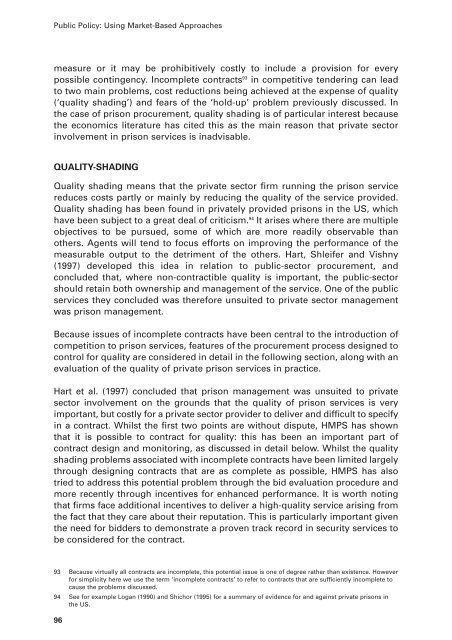Public Policy: Using Market-Based Approaches - Department for ...
Public Policy: Using Market-Based Approaches - Department for ...
Public Policy: Using Market-Based Approaches - Department for ...
Create successful ePaper yourself
Turn your PDF publications into a flip-book with our unique Google optimized e-Paper software.
<strong>Public</strong> <strong>Policy</strong>: <strong>Using</strong> <strong>Market</strong>-<strong>Based</strong> <strong>Approaches</strong><br />
measure or it may be prohibitively costly to include a provision <strong>for</strong> every<br />
possible contingency. Incomplete contracts 93 in competitive tendering can lead<br />
to two main problems, cost reductions being achieved at the expense of quality<br />
(‘quality shading’) and fears of the ‘hold-up’ problem previously discussed. In<br />
the case of prison procurement, quality shading is of particular interest because<br />
the economics literature has cited this as the main reason that private sector<br />
involvement in prison services is inadvisable.<br />
QUALITY-SHADING<br />
Quality shading means that the private sector firm running the prison service<br />
reduces costs partly or mainly by reducing the quality of the service provided.<br />
Quality shading has been found in privately provided prisons in the US, which<br />
have been subject to a great deal of criticism. 94 It arises where there are multiple<br />
objectives to be pursued, some of which are more readily observable than<br />
others. Agents will tend to focus ef<strong>for</strong>ts on improving the per<strong>for</strong>mance of the<br />
measurable output to the detriment of the others. Hart, Shleifer and Vishny<br />
(1997) developed this idea in relation to public-sector procurement, and<br />
concluded that, where non-contractible quality is important, the public-sector<br />
should retain both ownership and management of the service. One of the public<br />
services they concluded was there<strong>for</strong>e unsuited to private sector management<br />
was prison management.<br />
Because issues of incomplete contracts have been central to the introduction of<br />
competition to prison services, features of the procurement process designed to<br />
control <strong>for</strong> quality are considered in detail in the following section, along with an<br />
evaluation of the quality of private prison services in practice.<br />
Hart et al. (1997) concluded that prison management was unsuited to private<br />
sector involvement on the grounds that the quality of prison services is very<br />
important, but costly <strong>for</strong> a private sector provider to deliver and difficult to specify<br />
in a contract. Whilst the first two points are without dispute, HMPS has shown<br />
that it is possible to contract <strong>for</strong> quality: this has been an important part of<br />
contract design and monitoring, as discussed in detail below. Whilst the quality<br />
shading problems associated with incomplete contracts have been limited largely<br />
through designing contracts that are as complete as possible, HMPS has also<br />
tried to address this potential problem through the bid evaluation procedure and<br />
more recently through incentives <strong>for</strong> enhanced per<strong>for</strong>mance. It is worth noting<br />
that firms face additional incentives to deliver a high-quality service arising from<br />
the fact that they care about their reputation. This is particularly important given<br />
the need <strong>for</strong> bidders to demonstrate a proven track record in security services to<br />
be considered <strong>for</strong> the contract.<br />
93 Because virtually all contracts are incomplete, this potential issue is one of degree rather than existence. However<br />
<strong>for</strong> simplicity here we use the term ‘incomplete contracts’ to refer to contracts that are sufficiently incomplete to<br />
cause the problems discussed.<br />
94 See <strong>for</strong> example Logan (1990) and Shichor (1995) <strong>for</strong> a summary of evidence <strong>for</strong> and against private prisons in<br />
the US.<br />
96
















